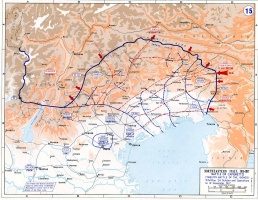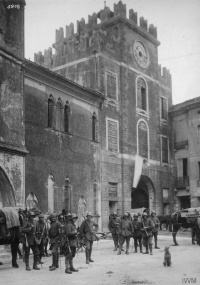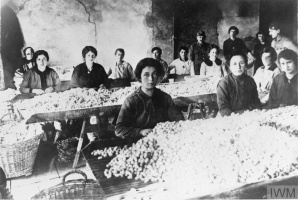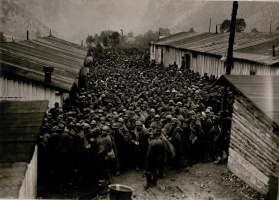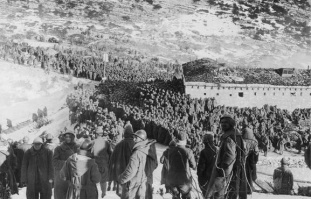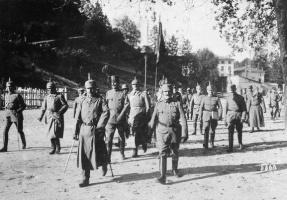Caporetto Defeat and Its Consequences↑
The joint offensive of the German and Austro-Hungarian armies against the Italian Front on 24 October 1917 had unprecedented success as troops broke the Italian lines near Caporetto and stormed into Friuli and the eastern Veneto plains. Many units fled or surrendered, but the bulk of the Italian army was able avoid encirclement and resisted behind the Piave river. The consequences of the Caporetto defeat were significant: 40,000 soldiers dead and wounded and another 294,000 taken prisoner. Moreover, fearing “German atrocities”, 250,000 civilians fled from the war zone with the retreating troops, becoming refugees, while 900,000 had to suffer enemy domination for a year.[1] The formation of the new battlefront along the Piave river caused the forced displacement of some 55,000 people towards Friuli.[2] The front came to a standstill until the end of the war. The occupied area, which covered the provinces of Udine, Belluno, Treviso, Venice and Vicenza (308 villages in 15,000 square kilometers), was divided into zones of Austrian and German occupation. Due to the ongoing military operations and the lack of staff and materials, the military authorities were not able to implement a structured policy. Therefore, political, economic and judiciary powers were assumed in January 1918 by the Austro-Hungarian supreme command led by General Svetozar von Bojna Boroević (1856-1920).[3] The occupied territories were governed by district and stage commandos (Etappen-Kommandos), while a military penal code (Militärstrafgesetz), curfew and passport (Ausweiskarte) were introduced to guarantee public order and curtail espionage.[4]
Violence, Crimes, and Forced Labor↑
From 1915 to 1917 the border areas occupied by Italian troops were subjected to nationalization policies. As a result, people who were considered loyal to the Habsburg Monarchy were interned; near the frontline populations were forcibly removed. Italian troops in some cases executed civilians accused of being francs-tireurs, such as in Villesse (Gorizia) or in the Slovene valleys in 1915.[5] After the Caporetto breakthrough, the civilian populations were again victims of a new wave of violence. Invading soldiers stormed cities and rural villages, looted, killed civilians, and raped women; acts of violence were perpetrated especially by German troops who had no interest in administering the invaded territories. Furthermore, the safety of the military was guaranteed with drastic measures, such as the execution of civilians (San Vito al Tagliamento) accused of being francs-tireurs, and the mass deportation of about 15,000 male civilians aged between fifteen and fifty capable of bearing arms, who were deported to Gorizia, Ljubljana or to concentration camps such as Katzenau (Austria) and Milowitz (Bohemia). Poorly fed and forced to work, about 1,500 internees died of starvation and disease.[6] After the first phase of invasion, the violence did not decrease but assumed multiple forms. As living conditions worsened, civilians were increasingly harassed, sequestrated, killed and beaten by individuals or groups of soldiers in search of food or valuables, whilst rapes occurred during military requisitions. The post-war “Royal Commission of Investigation on the Violation of People’s Rights” reported 553 “acts of cruelty” and 735 cases of rape, in which fifty-three women were killed.[7] Indeed, the number of rapes perpetrated was certainly higher – perhaps 2,000 – because many women refused to report the violence suffered to the authorities or because they were subject to family pressure. Considered crimes against “women’s honour”, rapes were not punished, and families and communities marginalized the victims and the “children of the enemy”.[8] Violence against civilians was also perpetrated through forced or voluntary recruitment of local workers. More than 73,000 civilians – men, women, boys, and girls – were forcibly recruited to transport ammunition under Italian artillery fire behind the Piave battlefront, to build trenches, bridges, depots, roads and railways, to farm the land, or work in local industries. As occurred in Belgium, in the spring and summer of 1918 about 5,400 people were transferred to the war industry in Austria and Germany. Civilian workers were victims of exploitation, inadequate nutrition, beatings, and temporary imprisonments. Hunger and privations blurred the boundaries between voluntary and forced labor and therefore the military corvée soon became a means used for economic purposes and to control the civilian population.[9]
Economic Exploitation and Occupied Society↑
The resistance of the Italian army and the worsening of living conditions due to the Entente blockade led to huge exploitation of local resources. On 15 December 1917, in Baden, the two allies established an agreement regarding the distribution of goods (a ratio of one to one), and decided that the occupying forces of one million soldiers should rely solely upon food from the occupied territories for their sustenance. In January 1918, the Austrian military economic group (Wirtschaftsgruppe) began utilizing these resources with the help of commands and provisional civil councils, which were forced to implement occupying policies. The ensuing economic exploitation was ruthless. Industrial machinery was dismantled, raw materials were seized, domestic items made of copper and tin, linen, bicycles, and even church organ pipes and the church bells of rural villages were removed.[10] In 1918, 5,529 wagons full of raw materials, foodstuffs, machinery and equipment were sent to the Central Powers.[11] However, foodstuffs for the occupying armies were the primary goal. In fact, commands requisitioned that year’s entire harvest, 320,000 cattle (85 percent of the total), 114,000 pigs (84 percent), and 90,000 sheep (70 percent). Food supplies for the civilian population were reduced and set at Austrian levels of 150 grams of maize flour per person per day in January 1918. Although there were some attempts to promote agricultural production, the lack of animals, seed, and fertilizer halved the 1918 harvest. Moreover, the introduction of the occupation currency known as “Lira Veneta” and the closure of mills and markets forced a return to barter practices. Shortages were so severe that this occupation was imprinted in the collective memory as “the year of hunger” because starving populations had to eat roots, tree leaves and grass.[12] The systematic plundering created a sort of competition for survival between the occupiers and occupied and modified social dynamics. While members of local civic councils such as priests and mayors tried to negotiate with commands in order to avoid hunger and violence, families joined and lived in the same house, hosted refugees and hid Italian prisoners. As heads of the household, women assumed unprecedented roles as they had to manage family survival, provide protection and emotional support, conceal food and animals, and participate in “hunger treks” towards the plains – often fifty to 150 kilometers on foot – in search of flour.[13] In addition, they also broke laws and military bans; a sample of judgments by the Austro-Hungarian military courts shows that women committed rural thefts and frauds (42.6 percent), violated circulation bans to seek food (24 percent), and refused to deliver goods during military requisitions (6.3 percent)[14]. On the other hand, deprivation forced the poorest women into clandestine prostitution. Living conditions deteriorated so dramatically that there were 24,597 deaths, of which 12,649 were attributed to insufficient healthcare, physical hardships, diseases (such as edema, smallpox, malaria, typhus, diphtheria, and the “Spanish flu”), and 9,797 to malnutrition and starvation.[15] While the annual average death rate in the invaded provinces before the war was seventeen per thousand, during the occupation it reached forty-five (in Treviso province 74.5 per thousand, in Belluno 56.8, in Venice 46.4, and in Udine thirty-three; in comparison, the Italian average was only twenty-eight).[16] Due to the requisitions, the enemy occupation was unpopular and there was no open collaboration by local civil authorities; indeed, few propaganda efforts were made. However, in the first months of 1918, commands issued the newspaper “La Gazzetta del Veneto” and promoted separatist propaganda in the local language Friulian, promising the distribution of abandoned lands among poor peasants. The schools were only opened in April 1918, but school soon become a means to exploit child labor. Isolated, severely hit by hunger and disease, and lacking political leadership, the population did not oppose the occupation forces and their morale was low. The “trauma” of the Caporetto defeat lasted until spring 1918. In this phase, apathy and moral suffering were widespread, but the failure of the Austro-Hungarian June offensive fueled hopes of liberation and “false news”. However, in late summer, war weariness increased prophecies and rumors of holy apparitions, whilst the autumn peace proposals raised new hopes of liberation.[17] The final offensive of Vittorio Veneto led to the collapse of the Austro-Hungarian army and the war ended on 4 November 1918. Joy and enthusiasm about liberation were short-lived because of the huge devastation, losses and the influenza pandemic; despite the final victory, society was divided as returning refugees accused the local mayors, priests and populations of collaborating with the enemy.
Italian Occupation of Austria 1918-1920↑
The clauses of the armistice signed on 3 November 1918 in Villa Giusti near Padua and the dissolution of the Habsburg Monarchy led Italy to play a new role in foreign policy. Between 3 and 9 November 1918, the Italian army occupied South Tyrol/Alto Adige, Trentino, Venezia Giulia (Gorizia, Trieste, Istria), Fiume (within an international military mission) and Dalmatia, which were territories claimed in the 1915 Treaty of London. Italian troops also marched beyond the armistice line; the Brenner Pass, Innsbruck and Landeck were occupied with the aim of securing the borders and of surveying the Bolshevik and South Tyrolean irredentist movements. Instead, Tarvisio and later Villach (Carinthia) were reached with the aim of guaranteeing the railway connections between Trieste and the Danubian area. In December 1918, a military mission led by General Roberto Segre (1872-1936) was also set up in Vienna with the purpose of defending “national interests” in Central Europe.[18] In the armistice phase, pending the peace negotiations and the definition of the borders (later regulated by the treaties of Saint-Germain and Rapallo), Italian military governments were established in the occupied territories with the task of preparing for the annexation.[19] The task was difficult not only because of serious post-war devastation and hardship, but also because there were hostile ethnic minorities: 221,000 German-speaking people in South Tyrol, and 500,000 Slovenians and Croatians in Venetia Giulia and Dalmatia. These populations wanted to live in a Slav state or claimed the right of self-determination.[20] In the occupied areas, the Italian army assumed executive powers; Trentino and South Tyrol were governed by General Guglielmo Pecori-Giraldi (1856-1941), Venezia Giulia by General Carlo Petitti di Roreto (1862-1933), Dalmatia and Pola by admirals Enrico Millo (1865-1930) and Umberto Cagni (1863-1932). The “Segretariato Generale per gli Affari Civili”, a military-civil organisation under the Italian supreme command, governed these territories; according to international conventions, previous legislation was maintained, but governors were also able to issue laws and bans.[21] The military governors tried to present themselves as “Italians” rather than as a “victorious power”, so they adopted a moderate and liberal integration policy; both Pecori Giraldi and Petitti di Roreto pragmatically respected the local institutions as they wanted to reinforce the Italian position at the peace conference; nonetheless, due to nationalism and imperialist issues, annexation was the first step towards the long-term cultural and political assimilation of the occupied populations. Initially, the Italian army had to restore public order, build infrastructure, organize food distribution, and ensure healthcare and subsidies for mutilated people, orphans and widows. The situation was catastrophic: in Trieste in November 1918 there were about 160,000 returning Italian prisoners of war, in spring 1919 in Trentino and Venezia Giulia 280,000 refugees had to be fed and accommodated.[22] “Bread diplomacy” and humanitarian assistance were used as a political means to impose new sovereignty and force the Austrian government to respect the armistice clauses.[23] Notwithstanding the financial difficulties of the Italian state, military governors solicited material reconstruction and economic restoration. Despite a liberal approach towards ethnic minorities, the outcomes were varied. In South Tyrol, Pecori-Giraldi pursued a policy of “reconciliation” and “pacific penetration”; therefore, the purge of civil servants was limited to high ranks, while hostile German-speaking mayors and schoolteachers were not removed. Moreover, the governor rejected the radical cultural policies supported by Ettore Tolomei (1865-1952), head of the governmental agency for the Italianization of South Tyrol.[24] In Venezia Giulia, instead, despite Petiti di Roreto’s moderate stance towards minorities and attempt to counter nationalist pressures, the military commands and local nationalist Italian organizations prevailed, although with non-organic measures and limited use of repression. The so-called “anti-italiani” were interned, the public administration was purged and Slovene and Croatian cultural and political associations were hampered.[25] In South Tyrol and Trentino, for example, Italian soldiers of the Habsburg Empire who fought on the “wrong side” were marginalized or at least interned as revolutionaries due to their wartime imprisonment in Russia.[26] Conflicts also occurred in Istria and Dalmatia, where the policies pursued by admirals Millo and Cagni were undermined by inadequate military resources and increasing opposition from the local churches and Slavs, and complicated by the legend of the “mutilated victory” of Gabriele D’Annunzio (1863-1938), which led to the illegal occupation of Fiume.[27] As a result, between 1918 and 1921 there was a sort of “ethnic metamorphosis”, as Trieste was no longer a multi-ethnic city, and the presence of minorities in Venetia Giulia was reduced by migration.[28] Finally, in order to shift from the armistice phase to annexation, in July 1919 the military governments were replaced by a civil administration (civil commissars, “Ufficio Centrale per le nuove province”).
Occupations: Memories and Legacies↑
Occupations during and after the war left moral and material scars on populations and territories which, in the public discourse, were overshadowed by the myth of “victory” and the nationalism pursued by liberal governments and by fascism. Obviously, the occupations had different goals; the Austro-German wartime occupation tried to alleviate the economic pressure of the Entente blockade, while the Italian post-war occupation was aimed at consolidating national borders and assimilating the populations of the former Austro-Hungarian Empire within the state. Although short-lived, the 1917-1918 Austro-German occupation caused huge losses and devastation. To some extent, the Austrian administration adopted techniques previously developed on the Eastern Front based on securing territory, controlling the population, occupation apparatus and currency, and forced labor, but military issues and economic exploitation had the upper hand over political management of the invaded areas. Although Austrian deputies suggested favourable treatment of Slovene and Friulian-speaking ethnic minorities as former loyal subjects of the Dual Monarchy, the requests were refused by General Boroevic, as these groups were considered “Italians”.[29] On the whole, German looting (November 1917-March 1918), military requisitions and lack of skilled functionaries prevented the use of industrial and agricultural assets. Transport systems were overstretched. The administration proved chaotic and ineffective and failed at the task of ensuring adequate food both for the occupying armies and the Austrian home front – so much so that the June offensive (the “Hunger Offensive”) was planned in order to obtain new food resources. The more living conditions deteriorated, the more soldiers’ banditry rose; the Hague Conventions of 1907 were not respected. Violence and exploitation were justified not only as a “natural” issue (“Krieg ist Krieg!”) but also as a consequence of the Italian “betrayal” of 1915 and the Entente blockade. In the long run, the Caporetto breakthrough was a “Pyrrhic victory”, a sort of burden that worsened the position of the Habsburg Monarchy.[30] At the end of the war, in the so-called “liberated territories” of eastern Veneto and Friuli, infrastructure, industry and agriculture were devastated; more than 165,000 houses and public structures were severely damaged or destroyed.[31] The slow reconstruction and the post-war “weakness” of the Italian state had long-lasting consequences for north-eastern regions as they triggered dialectics about the centre and the periphery. Between 1919 and 1921, the populations of the Udine, Belluno and Treviso and Trento provinces protested as they felt abandoned and poorly considered by the government. This situation fuelled autonomist ideas and the will to complete reconstruction with local financial institutions.[32] Dissatisfaction was also widespread in South Tyrol due to the Italian “occupation”, deprivation and a different conversion of currency; in Trentino the Catholic party led by Alcide De Gasperi (1881-1954) criticized the governor’s centralization policy and opposed municipal and provincial autonomies; in both regions, the dissatisfaction about the Italian apparatus paved the way for the “myth” of the effectiveness of the Habsburg administration. In 1918-1919, the Italian occupations were an attempt by the liberal ruling classes to play a new role in the Danubian area and, in the meantime, overcome the internal crisis. These goals soon clashed with financial and political difficulties and the opposition of the United States, Great Britain and France. Despite the liberal policies pursued by military governors, imperialistic and nationalist issues legitimized anti-German and anti-Slavic issues. From this point of view Italians represented themselves not only as “liberators” but also as civilizers and “defenders” of the new Italian borders from foreign threats and bolshevism. In contrast, ethnic minorities felt menaced by Italianization and tried to preserve their cultural difference. On the whole, the war and occupations radicalized nationalism and engendered, as in Venetia Giulia, an escalation of conflicts between organizations such as the “Fasci di Combattimento”, Slavs and socialist movements. The following forced Italianization of border areas, which would later be pursued by fascism, led to long-lasting hostility and outbursts of violence, terrorism, and ethnic cleansing.
Matteo Ermacora, University of Venice
Reviewed by external referees on behalf of the General Editors
Notes
- ↑ On the Caporetto defeat and its consequences: Isnenghi, Mario / Rochat, Giorgio: La Grande Guerra 1914-1918, Bologna 2008, pp. 381-382; Labanca, Nicola: Caporetto. Storia e memoria di una disfatta, Bologna 2017; Ceschin, Daniele: Gli esuli di Caporetto. I profughi in Italia durante la Grande Guerra, Rome et al. 2006, pp. 5-46.
- ↑ Corni, Gustavo: La società veneto-friulana durante l’occupazione militare austro-germanica 1917- 1918, in: Corni, Gustavo / Bucciol, Eugenio / Schwarz, Angelo (eds.): Inediti della Grande guerra. Immagini dell’invasione austro-germanica in Friuli e nel Veneto orientale, Portogruaro 1990, pp. 40-42.
- ↑ Rauchensteiner, Manfried: The First World War and the End of the Habsburg Monarchy, Vienna et al. 2014, pp. 796-797.
- ↑ Horvath-Mayerhofer, Christine: L’Amministrazione militare austro-ungarica nei territori italiani occupati dall’ottobre 1917 al novembre 1918, Udine 1985, pp. 139-141.
- ↑ On internment and forced displacement: Milocco, Sara / Milocco, Giorgio: Fratelli d’Italia. Gli internamenti degli italiani nelle terre liberate durante la guerra, Udine 2002; Museo storico italiano della guerra, Annali 17-22 (2009-2014); on internments and Italianization policies in Trentino: Frizzera, Francesco: I profughi trentini nella Grande Guerra. Identità multiple, fedeltà percepita, welfare statale, PhD Thesis, University of Trento, 2014-2015, pp. 355-367. On shootings: Sala, Teodoro: “Redenzione” e “conquista”. La guerra del 15-18 al confine orientale. I fucilati del 29 maggio 1915 a Villesse, in: Bollettino dell’Istituto regionale per la storia del movimento di liberazione nel Friuli Venezia-Giulia 1-2 (1975), pp. 5-7; Svolsjak, Petra: L’occupazione italiana dell’Isontino dal maggio 1915 all‘ottobre 1917 e gli sloveni, in: Qualestoria 1-2 (1998), pp. 33-64.
- ↑ Archivio Centrale dello Stato, Presidenza del Consiglio dei Ministri, Reale Commissione d’inchiesta sulle violazioni del diritto delle genti commesse dal nemico, b. 16, fasc. 176, Violazioni del diritto delle genti al fronte italiano, pp. 7-8.
- ↑ The Italian government ignored the request to punish 270 Austrian and German war criminals after the peace treaties were signed. La Lumia, Cristiano: La politica dell’oblio. La mancata punizione dei crimini di guerra tra Italia, Austria e Ungheria dopo la Grande guerra (1918-1921), in: Qualestoria 46 (2018), pp. 35-50.
- ↑ Ceschin, Daniele: L’estremo oltraggio. La violenza alle donne in Friuli e in Veneto durante l’occupazione franco-germanica (1917-1918), in: Bianchi, Bruna (ed.): La violenza contro la popolazione civile nella Grande guerra. Deportati, profughi, internati, Milan 2006, pp. 165-184.
- ↑ Ermacora, Matteo: “Costretti a lavorare per il nemico”. Il lavoro coatto nel Veneto e nel Friuli invasi 1917-1918, in: Ermacora, Matteo (ed.): Le “disfatte” di Caporetto. Eserciti, popolazioni, territori, Trieste 2019, pp. 41-62.
- ↑ Rauchensteiner, First World War 2014, p. 857.
- ↑ Horvath-Mayerhofer, L’amministrazione 1985, pp. 59-71.
- ↑ Relazioni della Reale Commissione d’Inchiesta sulle violazioni del diritto delle genti commesse dal nemico, volume 6, Milan et al. 1920, pp. 180, 624-626.
- ↑ Ermacora, Matteo: Inside the Storm. The Experiences of Women during the Austro-German occupation of Veneto 1917-1918, in: Bianchi, Bruna / Ludbrook, Geraldine (eds.): Living War, Thinking Peace (1914-1924). Women’s Experiences, Feminist Thought and International Relations, Newcastle 2016, pp. 26-43.
- ↑ Ermacora, Matteo: Nei tribunali dell’occupante. Donne e giustizia militare austriaca in Veneto (1917-1918), in: Dep. Deportate, esuli, profughe. Rivista telematica di studi sulla memoria femminile 31 (2016), pp. 164-165.
- ↑ Relazioni della Reale Commissione, volume 4, 1920, pp. 181-185.
- ↑ See: Mortara, Giorgio: La salute pubblica in Italia durante e dopo la guerra, New Haven 1925, pp. 79-80.
- ↑ Ermacora, Matteo: Sotto assedio. La popolazione veneto friulana dopo Caporetto, in: Vecchio, Giorgio / Gotti, Gabriella (eds.): Il paesaggio violentato. Le due guerre mondiali, le persone, la natura, Rome 2020, pp. 247-258.
- ↑ Di Michele, Andrea: Al di qua e al di là delle Alpi. Piani italiani di espansionismo in Tirolo (1918-1920), in: Italia contemporanea 256-257 (2009), pp. 441-459; Caccamo, Giulia: L’occupazione italiana della Carinzia, in: Italia contemporanea 256-257 (2009), pp. 461-469.
- ↑ Monzali, Luciano: La politica estera italiana nel primo dopoguerra 1918-1922. Sfide e problemi, in: Italia contemporanea 256-257 (2009), pp. 379-406.
- ↑ Di Michele, Andrea: L’Italia in Austria. Da Vienna a Trento, in: Raoul, Pupo (ed.): La vittoria senza pace. Le occupazioni militari italiane alla fine della Grande Guerra, Rome et al. 2014, p. 30.
- ↑ Capuzzo, Ester: Dal nesso asburgico alla sovranità italiana. Legislazione e amministrazione a Trento e Trieste (1918-1928), Milan 1992, pp. 13-58.
- ↑ Visintin, Angelo: Militari, territorio e popolazioni della Venezia Giulia del primo dopoguerra (1918-1919). La ricostruzione dell’Isontino, in: Esercito e città dall’unità agli anni Trenta, Rome 1989, pp. 1228-1232.
- ↑ Di Michele, L’Italia in Austria 2014, p. 66.
- ↑ Mezzalira, Giorgio: Per una “politica ferma e risoluta”. L’occupazione italiana in Alto Adige nei rapporti tra Tolomei e Pecori Giraldi, in: Italia Contemporanea 256-257 (2009), pp. 431-440.
- ↑ Pupo, Raoul: Attorno all’Adriatico. Venezia Giulia, Fiume e Dalmazia, in: Pupo, Raoul (ed.): La vittoria 2014, pp. 103-113.
- ↑ Antonelli, Quinto: I dimenticati della Grande Guerra. La memoria dei combattenti trentini (1914-1920), Trento 2008; Rasera, Fabrizio: Primo dopoguerra e governo militare in Trentino, in: Italia contemporanea 256-257 (2009), pp. 407-418.
- ↑ Pupo, Raoul: “Destreggiarsi”. Una lettura dell’amministrazione militare italiana della Dalmazia 1918-1920, in: Italia Contemporanea 256-257 (2009), pp. 511-523; Monzali, Luciano: Italiani di Dalmazia 1914-1924, Rome 2007, pp. 58-64.
- ↑ Purini, Piero: Le metamorfosi etniche di Trieste nel periodo 1914-1919, in: Annales. Series Historia et Sociologia 2 (2002), pp. 341-362. According to the 1921 census, the Slovenian and Croatian populations were reduced from 466,000 to 349,000, whereas the Italian presence rose from 354,000 to 467,000.
- ↑ Horvath-Mayerhofer, L’amministrazione 1985, pp. 112-113.
- ↑ Rauchensteiner, First World War 2014, pp. 785-786.
- ↑ Zadra, Camillo: Paesaggi di guerra. Il Trentino alla fine della prima guerra mondiale, Rovereto 2010; Treccani, Gian Paolo: Monumenti e centri storici nella stagione della grande guerra, Milan 2015.
- ↑ On post-war reconstruction: Camera dei Deputati: Commissione parlamentare d’inchiesta sulle terre liberate e redente (luglio 1920 - giugno 1922), volume 1, Saggi e strumenti di analisi, Rome 1991; Fumian, Carlo: Il secondo Risorgimento delle Venezie. La ricostruzione dopo la Grande Guerra, Venice 2015.
Selected Bibliography
- Camera dei Deputati: Commissione parlamentare d’inchiesta sulle terre liberate e redente 1920-1922, Rome 1991.
- Capuzzo, Ester: Dal nesso asburgico alla sovranità italiana. Legislazione e amministrazione a Trento e a Trieste 1918-1928, Milan 1992: Giuffrè.
- Casagrande, Giuliano: L'isola tra i fiumi. Sopravvivere all'invasione 1917-1918, Treviso 2018: ISTRESCO.
- Cecotti, Franco (ed.): Un esilio che non ha pari. 1914-1918. Profughi, internati ed emigrati di Trieste, dell'Isontino e dell'Istria, Triest 2001: Gorizia.
- Ceschin, Daniele: Gli esuli di Caporetto. I profughi in Italia durante la Grande Guerra, Rome; Bari 2006: Laterza.
- Corni, Gustavo: Die Bevölkerung von Venetien unter der österreichisch-ungarischen Besetzung 1917/18, in: Zeitgeschichte 7-8, 1989-1990, pp. 311-329.
- Ellero, Elpidio: Caporetto, il prezzo della sconfitta. Ottobre 1917-novembre 1918, Udine 2013: Gaspari.
- Ermacora, Matteo (ed.): Le 'disfatte' di Caporetto. Soldati, popolazioni, territori 1917-1919, Triest 2019: Edizioni Universitá di Trieste.
- Kramer, Alan: Dynamic of destruction. Culture and mass killing in the First World War, Oxford; New York 2007: Oxford University Press.
- Laboratorio di Storia di Rovereto (ed.): Gli spostati. Profughi, Flüchtlinge, Uprchlíci 1914-1919. La storia, volume 2, Mori 2015: Laboratorio di storia di Rovereto; Presidenza del Consiglio della Provincia Autonoma di Trento.
- Pupo, Raoul (ed.): La vittoria senza pace. Le occupazioni militari italiane alla fine della Grande Guerra, Rome 2014: Editori Laterza.
- Rauchensteiner, Manfried: The First World War and the end of the Habsburg monarchy, 1914-1918, Vienna 2014: Böhlau.
- Relazioni della reale commissione d'inchiesta sulle violazioni del diritto delle genti commesse dal nemico, volume 7, Milan 1920-1921: Casa Editrice d'Arte Bestetti & Tumminelli Milano-Roma.
- Visintin, Angelo: L'Italia a Trieste. L'operato del governo militare italiano nella Venezia Giulia, 1918-1919, Gorizia 2000: LEG.





